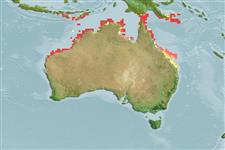Elasmobranchii (tubarões e raias) (sharks and rays) >
Orectolobiformes (Carpet sharks) >
Orectolobidae (Carpet or nurse sharks)
Etymology: Orectolobus: orektos (Gr.), stretched out; lobus (L.), from lobos (Gr.), rounded projection or protuberance, referring to long nasal barbels of Squalus barbatus (=O. maculatus). (See ETYFish); wardi: In honor of Australian actor, musician and naturalist Charles Melbourne Ward (1903-1966), who collected holotype. (See ETYFish).
More on author: Whitley.
Environment: milieu / climate zone / depth range / distribution range
Ecologia
marinhas associadas(os) a recifes; intervalo de profundidade 1 - 3 m (Ref. 43278). Tropical; 9°S - 26°S, 114°E - 154°E
Western Central Pacific: Australia.
Tamanho / Peso / Idade
Maturity: Lm ? range ? - ? cm
Max length : 63.0 cm TL macho/indeterminado; (Ref. 6871)
Espinhos dorsais (total) : 0; Espinhos anais: 0. Dark rounded saddles with light outlining widely spaced by dusky areas and with a few dark spots; saddles on head and trunk forming conspicuous eyespots (Ref. 13577). Caudal fin with its upper lobe hardly elevated above the body axis, with a strong terminal lobe and subterminal notch but no ventral lobe (Ref. 13577).
Found on the continental shelf, commonly inshore (Ref. 247). Presumably feeds on bottom invertebrates and fishes, but diet still unrecorded (Ref. 13577, 43278). Probably ovoviviparous (Ref. 13577, 43278). Wobbegongs should be regarded as potentially dangerous because of their formidable teeth (Ref. 247, 13577).
Life cycle and mating behavior
Maturities | Reprodução | Spawnings | Egg(s) | Fecundities | Larvas
Ovoviviparous, embryos feed solely on yolk (Ref. 50449).
Compagno, L.J.V., 1984. FAO Species Catalogue. Vol. 4. Sharks of the world. An annotated and illustrated catalogue of shark species known to date. Part 1 - Hexanchiformes to Lamniformes. FAO Fish. Synop. 125(4/1):1-249. Rome, FAO. (Ref. 247)
Categoria na Lista Vermelha da IUCN (Ref. 130435)
Ameaça para o homem
Traumatogenic
Utilização humana
Pescarias: pouco comercial
Ferramentas
Relatórios especiais
Descarregue XML
Fontes da internet
Estimates based on models
Preferred temperature (Ref.
123201): 26.5 - 28.7, mean 28 °C (based on 253 cells).
Phylogenetic diversity index (Ref.
82804): PD
50 = 0.5012 [Uniqueness, from 0.5 = low to 2.0 = high].
Bayesian length-weight: a=0.00389 (0.00180 - 0.00842), b=3.12 (2.94 - 3.30), in cm total length, based on all LWR estimates for this body shape (Ref.
93245).
Nível Trófico (Ref.
69278): 4.0 ±0.61 se; based on food items.
Resiliência (Ref.
120179): Baixo, tempo mínimo de duplicação da população 4,5 - 14 anos (Fec assumed to be <100).
Fishing Vulnerability (Ref.
59153): Moderate to high vulnerability (45 of 100).
Nutrients (Ref.
124155): Calcium = 23 [4, 93] mg/100g; Iron = 0.446 [0.106, 1.244] mg/100g; Protein = 19.7 [17.4, 21.9] %; Omega3 = 0.073 [0.030, 0.179] g/100g; Selenium = 14.6 [3.9, 44.0] μg/100g; VitaminA = 67.4 [21.7, 190.8] μg/100g; Zinc = 0.967 [0.439, 2.052] mg/100g (wet weight);
